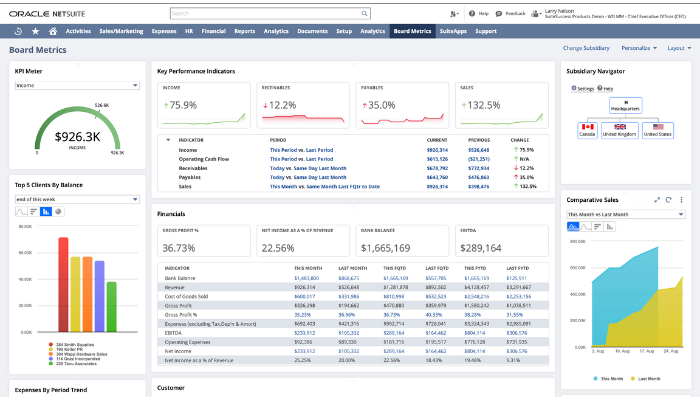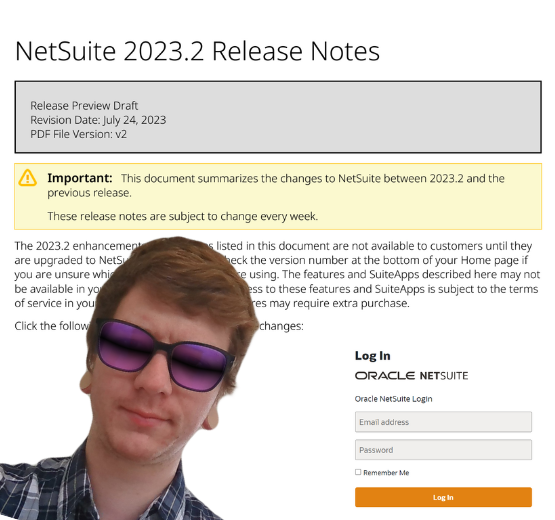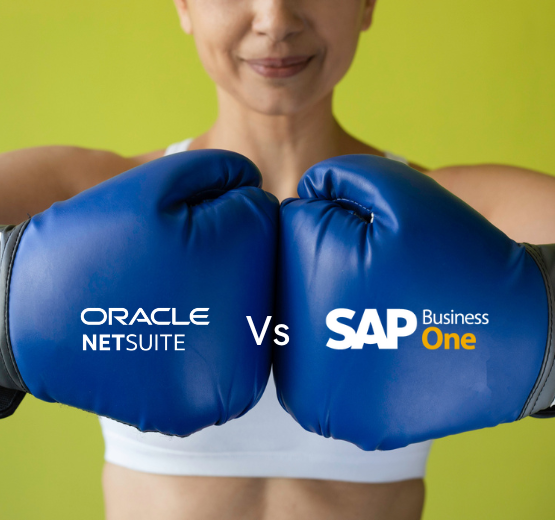Nowadays, businesses accrue increasing amounts of data – whether they’re growing or not. The challenge is collecting and using that data wisely.
They could use numerous, siloed software solutions that handle finances, CRM, supply chain management, and reporting separately. But they might struggle to get these solutions to “talk to” each other effectively, and any manual coordination eventually becomes another time cost added to what might already be an exponentially growing list.
Or they could invest in an Enterprise Resource Planning (ERP) system that handles all of the above functionality in stride and then some. And if you’re worrying about Sage 1000 and Sage Line 500’s forthcoming end of life, now may be the time to take the ERP plunge.
Today, we’ll compare two popular ERP contenders for the small to medium business market: Oracle NetSuite and SAP Business One.
What is Oracle NetSuite?
NetSuite is a massively feature-rich, cloud Enterprise Resource Planning (ERP) and business management tool; ideal for businesses of any size, location, or sector. It allows you to manage financials, inventory, prospect relationships, customer subscriptions, and even e-commerce operations – and more – with ease.
One of NetSuite’s many plus points is its boundlessly granular reporting capability – whether you want a high-level, bird’s-eye view or dive into the data and undertake granular analysis, NetSuite can accommodate.
What is SAP Business One?
SAP Business One is a business management and Enterprise Resource Planning (ERP) platform, targeted at the small to medium enterprise market. It can handle a wide range of business functions, including accounting, sales, inventory, reporting, and more. It was developed to provide a simple and effective ERP solution, designed and streamlined especially for SMEs.
For brevity, we will occasionally refer to SAP Business One as “B1” during this article.
Let’s crack on with the Oracle NetSuite vs. SAP Business One comparison…
Functionality

NetSuite users enjoy a natively rich ERP feature set including accounting and financials; multi-entity consolidations; sales and purchasing functionality; warehouse and distribution management; bill of materials; CRM; analytics, and much more. NetSuite has vast global appeal as it is available in 27 languages and handles taxes and reporting for over 100 countries.
SAP Business One provides a very similar feature set, including accounting, purchasing, inventory, CRM, sales, and analytics. It is focused on providing smaller businesses with a scaled back version of the same ERP functionality enjoyed by larger enterprises, though we’d argue that these smaller businesses can easily enjoy exactly the same functionality as larger firms… by choosing it! (It’s called NetSuite, by the way!)
Joking aside, there are a few differentiators that set Business One apart. On the surface, B1 appears to have a few tricks up its sleeve that might be of interest to manufacturers. Yet this is a key market focus for NetSuite too, with new functionality for manufacturing and warehousing being added with every update.
While B1 features some HCM functionality out of the box, NetSuite achieves this through the natively compatible (and easily incorporated) SuitePeople add-on. B1 also is compatible with a number of other SAP owned products like SAP Ariba and has native integration with Microsoft products.
In terms of localisations, SAP marketing materials claim to support 100+ countries, though some of these fall into their “pre-localised” bucket or they delegate creating that functionality to partners.
Therefore, there are a few key aspects that ultimately put NetSuite on top. NetSuite’s CRM is far more feature rich than B1’s. Financial consolidations are a part of NetSuite’s core functionality, where B1 only achieves this via add-ons. Plus, e-commerce and subscription-based businesses will be much better served by NetSuite, which features integrated e-commerce and subscription management functionalities.
Cloud Access
Similar to Sage X3 – which we pitted against NetSuite recently in a best ERP contest – SAP Business One is in the cloud, but also isn’t.
In May 2020, SAP released web client functionality for the platform, which we feel was a step in the right direction. Until then, users had to rely on solutions like Windows Terminal Server or Citrix to “dial in” to the system if they needed remote access. However, this web client functionality is still not “true” cloud ERP – Business One still needs to be installed on a server by the user’s SAP partner.
Though the capability is there to deploy SAP Business One on a cloud server, it is still a siloed installation that has no real connection to SAP’s central systems and needs to be manually updated by the user’s SAP partner. This all adds complexity to B1’s upkeep. Updates are a particular concern here: if the onus is on the user to engage their partner for updates, there is a considerable risk of not always being on the latest version with the latest security updates and functionality. A significant budget should also be set for such updates and any resulting reconfigurations that need to be undertaken. There are also reported issues with SAP add-ons’ compatibility with the new SAP web client.
NetSuite however is a “true” cloud ERP. There is no local server software to install, it is housed totally on Oracle’s own servers and all accessed through any modern web browser. This means that Oracle can deploy updates automatically as soon as they are ready – meaning all users will be using the latest version without having to involve partners or third parties.
We also compared Sage 200 with NetSuite and looked at whether Sage Intacct or NetSuite might be better for your business.
Analytics and Reporting

Reporting is one arena where NetSuite is the clear victor. To achieve effective reporting, many SAP users rely on add-ons; either Crystal Reports (which can be rather technical for general users) or SAP Analytics Cloud (which is a separate product with a separate cost). Customisations to either of these platforms need to be undertaken by a software implementation partner – all adding cost and complexity.
NetSuite, on the other hand, has enviably robust reporting capabilities out of the box. Its centralised, silo-less database allows for native, granular reporting, with custom reports and dashboards created with minimal training and a few clicks.
Flexibility and Configuration
You might well and truly lament the surprising rigidity inherent in B1. Providers often celebrate its configurability, but also often neglecting to mention that additional modules are sometimes needed to improve essentials like “usability,” “screen design,” and “data management.” On the other hand, NetSuite users can create custom reports, add custom fields and even formulate automated workflows themselves with a spot of training.
In terms of optional add-ons, SAP boasts that it has “more than 1,800 enterprise solutions” available on its SAP Store. This is true. However, when you filter these solutions by compatibility with Business One, you get a rather paltry 47 at the time of publishing – and only a handful of them receive SAP’s “SAP Certified” endorsement. Also, according to one SAP partner, SAP hasn’t made it easy for partners to make their add-on solutions ready to run on the SAP web client, furthering the functional gulf between “web client” users and on-prem SAP users.
NetSuite’s SuiteApp add-on store features over 600 solutions to enrich and expand your use of NetSuite. We’re partners with some of the very best too.
Business growth also requires a certain degree of flexibility. If you are a small business with your sights on expansion, know that NetSuite is fully capable of providing sturdy ERP functionality to organisations of all sizes, be they small, medium, large, or multinational! In fact, NetSuite is delightfully global, with localisations for 100+ countries and available natively in 27 languages; so if you’ve got your sights on world domination, NetSuite’s the platform to do it with!
Contrast this with SAP Business One which is squarely focused on the SME market – making it easier to outgrow. This would leave you needing to start the software acquisition process anew at what could be a crucial time in your business’s development… where your attention might really be needed elsewhere! Plus, if you’re one of the thousands of businesses currently using Sage 1000 or Sage Line 500 – and are therefore being forced to switch systems due their fast-approaching end-of-life deadlines – we have a feeling you won’t appreciate needing to go through the process again in a few years.
Support and Updates

To echo some of the points from our “cloud” section above – because SAP Business One relies on being installed on a server by you or your partner, SAP themselves don’t have direct line of sight to that installation. This leaves support, troubleshooting, and updates squarely in the hands of software partners.
This disjointed approach means that it’s likely that some users will not be using the latest version. There may even be a small (or perhaps not so small) contingent of organisations who are deliberately putting off an update or a crucial bit of upkeep due to cost or upheaval. With cyber threats becoming increasingly ruthless, this can be a dangerous game to play.
With NetSuite, however, this issue is totally sidestepped by being fully cloud-based. Oracle produce updates for NetSuite twice a year, and these are automatically pushed out to every single user; nobody’s left behind on an older version, nobody’s left without the latest security updates, and nobody is left out of pocket for the privilege of updating (apart from the unlikely event that relied upon third-party add-ons need re-optimising after an update).
Are you researching a variety of ERP solutions? Head over to the contest between NetSuite and Microsoft Business Central.
Switchover Speed
The length of time that any ERP implementation project takes depends heavily on the complexity of the business at hand; the formats and quantity of any data that needs converting; and the individual feature sets that are most essential to the company. Though with that out of the way, it is important to acknowledge that the platform chosen can have some impact on turnaround speed.
There doesn’t seem to be a consensus as to how long an implementation of B1 will take. One SAP provider down under said they’ve heard businesses quote everything from 2 weeks to 12 months! Looking around at other SAP partners online, 3-6 months (again, depending on client need) seems to be a fair estimate considering that B1 is focused more on the SME market.
NetSuite fares similarly, taking anywhere between 2-6 months to implement and embed; but again, depending on the client’s own complexity, the number of business subsidiaries and whether a strategic phased approach is being taken, a project can take as long as a year. Please, get in touch to have a no obligation chat with us and when we learn a little bit more about your requirements, we can give you example timelines of similar projects.
However, it’s essential to remember that when people ask “how long will it take?” they often mean “how soon will we start to see value?” BrightBridge frequently promotes a phased implementation for NetSuite, informed by your business priorities and KPIs; getting you using the platform – and seeing the benefits – sooner.
Cost

On the surface, SAP Business One appears to be relatively inexpensive, especially if you opt for the Starter Package or the mid-range “Limited User” license. However, when you get into the detail for B1, you soon start to realise that there is far more than a simple flat fee at play.
In fact, hidden SAP Business One costs can vary pretty wildly. There are a number of considerations that can affect cost, including number of users, hardware requirements, support/update services, geographic location, and the need for any add-on solutions or customisation. The hidden costs soon stack up.
The simplicity of NetSuite’s costing makes it a much more attractive and easily budgetable choice. It’s totally cloud-based, so no need to invest in cloud or on-prem servers yourself. As with any ERP, NetSuite comes with a professional services requirement (a partner like us for implementation and subsequent work) and the only other investment needed is your annual subscription.
And what’s more, with Oracle Finance, you can spread the costs over two and three years!
Our Verdict

All considered, yes SAP Business One can seem like a simple, affordable solution on the surface, but its reliance on a small handful of add-ons for essential functionality, its array of hidden costs, and its sheer “outgrowable-ness” mean that it doesn’t make our personal cut for most use cases.
B1 does include some extra out-of-the-box functionality for HCM and manufacturing that might turn a few heads, but manufacturing is a key market for NetSuite too. NetSuite has countless manufacturing-specific applications (and the list is always growing) and more out-of-the-box features are about to land in the 2023.1 update.
NetSuite is a powerful cross-industry, cross-functional, international ERP solution. If you’re looking for a joined-up piece of software to help you steer your company through growth and beyond, NetSuite is, hands-down, our pick.
NetSuite is intuitive to use, its costs are transparent, it’s flexible, and it’s a “true” cloud offering that breaks down any hurdles to hybrid working – what’s not to like? It’s also hugely capable in the analytics department, with granular reporting options that allow you to zoom in or out as much as you need to get the data you’re looking for.
Pondering your next digital transformation? BrightBridge specialise in pairing businesses like yours with the best possible ERP and CRM solutions for their needs. We’d love to hear what you’d like to achieve – request a call back from one of our specialists today!
Keep reading

What is a NetSuite implementation partner? How do you choose one?

Technology fit for total customer service in 2024

Retail and wholesale distribution: how to improve supply chains

Ditching Sage 1000: what you need to know from businesses that have done it

6 ways AI-ready Microsoft Dynamics 365 helps chartered associations serve members

6 retail and wholesale distribution challenges and how NetSuite solves them

The most exciting features in Microsoft Dynamics 365 2023 Release Wave 2

How to manage a new NetSuite Release: one expert's update process

What’s in NetSuite Release 2023.2?

